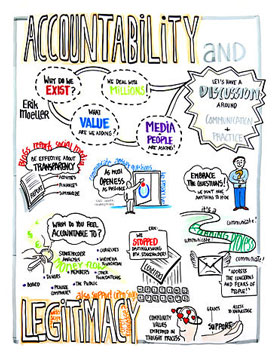Gene Morton
If the news reports are accurate, the Chipotle Mexican Grill business is a case worth watching by those of us interested in reorganizations, leader development, organization effectiveness, and leader succession. For over a year this company has been in a sad, downward spiral. Meanwhile, they still capture the imagination of investors and customers with their unique nutritional offerings. How can an organization with such huge potential and garnering so much praise fall so quickly? The answer lies in their outmoded leadership structure and its pivot point–individual accountability.

Anna Lena Schiller – Own work, CC BY-SA 3.0 (http://annalenaschiller.com)
As with almost every food service business, the leaders’ goal is sustainability, with any luck into the next few generations. This is true for almost any food service business. But when its leaders are not aware of or are unable to fulfill their accountability for delivering reliable and high-quality food, customer loyalty is reduced, leaders lose their enthusiasm, and long-term growth is not likely. The leaders have not…created Clarity, Focus, Accountability, and Commitment among themselves.
Has Chipotle designed and implemented a new leadership structure to support the survival and prosperity of their company? After their business disasters, it would seem to be a logical action. Unfortunately, with no evidence to the contrary, it appears they have ignored their leadership structure and left it in disarray.
- They reduced their leaders’ clarity by adopting a dual, co-CEO, leadership arrangement. This can increase misunderstanding and confusion all up and down the line. That’s why co-CEO partnerships are discouraged as a leadership structure. It is a most difficult working relationship to coordinate.
- There is no evidence that they have defined their business outcomes. Without these definitions, it is more difficult for everyone to focus on what’s most important to their customers.
- There are no signs anyone negotiated the distribution of accountability at the top to make sure someone was on constant alert to deliver every business outcome.
- Is anyone negotiating for the leaders’ commitment to take responsibility, improve their operations, and fulfill their accountabilities?
Shareholders’ Wake-up Call
Frustrated Chipotle shareholders filed a claim against their executives. Then some of the top managers even fell under criminal investigation. Shareholders claim the leaders are liable for the loss of share value due to costly management mistakes. In a Denver Post article, shareholders claim Chipotle leaders allowed unsafe food handling practices to continue even after people became ill. Is it clear even today who is accountable for food handling?
Will any legal action truly compensate shareholders, and the victims of foodborne illness, for their losses of health, time and money? Why is Chipotle risking more lawsuits before reorganizing their leaders? Why not reorganize the leaders now so that the company’s offerings are positioned to attract new customers? It could save the company and create jobs.
Learning Creates Winners
If the leaders, participants, and observers of Chipotle’s case learn how to manage accountability—how to locate it and how to spot those able to fulfill it—everyone could win in this company turnaround: customers, investors, suppliers, and employees.
Some might ask, “How would they start to improve the effectiveness of their leadership structure?” They can start by answering questions like these.
- What arrangements in your current leadership structure make it possible for your executives, time after time, to fail to correct for repeated outbreaks of foodborne illness?
- Why are customers put at risk and headlined in the news media before their serious illnesses are acknowledged?
- How are your Chipotle managers applying accountability? Do they understand what it is and what it means?
- How is the accountability for food safety and quality spelled out? Are you still confused about the accountability for delivering outcomes?
- Who has accepted accountability for food quality and safety? Is a leader identified by name? Does this leader agree to accept it?
- What fail-safe mechanisms are in place to ensure food is well prepared every time and at all times? If so, have they been tested to make sure that if they fail they will fail safe?
Are Chipotle’s Individual Accountabilities Clear—Defined, Accepted, and Integrated Among the Leaders?
While such arrangements are often taken for granted or deemed too basic for the attention of those in the Chief suites they are the bedrock of a leadership structure. Accountabilities are bedrock. When leaders have not spelled out the expectations about accountabilities and roles, they are likely to confuse everyone. Without clarity the stress on the top of the company ladder increases. Executives can find themselves running all day to keep up with unexpected emerging issues. They are overwhelmed. What is worse, though, is how this void gets filled with power grabs, internal competition, lack of initiative, and chronic conflict among the executives and managers. These are leading indicators of confusion over accountability. If you have these problems in your organization, accountabilities are probably not clear.
Everyone wishes for a fair and just verdict for Chipotle and its injured shareholders and customers. Meanwhile, as they make their recovery, let’s pay attention to how this Chipotle dispute unfolds. We might learn from their painful experiences and ask ourselves what errors and omissions in leadership structure are present in our own companies? Here are some questions for us all.
- Have we defined our own critical outcomes and negotiated the accountability for each? This helps to ensure product and service quality and safety might never become a customer’s problem. Why? Because we have identified what leaders we can count on to make sure customers only receive top quality products and services.
- Have we identified our product or service delivery team members? Have we assured they have the expertise, input, and experience needed to deliver our most critical business outcomes?
- Have we clarified roles and responsibilities among our team members? What about the roles of those who must support accountable leaders as they work to deliver a customer trusted outcome, for example, a satisfying, nutritious, and safe meal?
- Finally, have we set in place the internal feedback triggers we need to make sure business killing mistakes are corrected inside, here and now, before our process problems become customer problems?
Defining the six to 12 critical outcomes for the survival of a business is imperative in achieving a sustainability. Focusing and acting to deliver these outcomes will only occur in the presence of accountability, modeled by the leadership team.
Leaders and Coaches Invited! Accountability Tool and Podcasts
We have created a simple tool for those who wish to measure the clarity of accountability within organizations. Simply send a request to info@genemorton.com and provide your best e-mail address to receive a copy of this tool.
For more on outcome accountability, see our podcast episodes 5 and 6 at Lucrative Leadership Conversations.
*Note: The intention of this article is to provoke thoughtful conversation about how leaders can better lead together. Although originally written in August 2016, the release of this article was postponed as Chipotle worked through some complex top management choices. With the appointment of, Steve Ells, as the single CEO, and the involvement of activist shareholder, Bill Ackman, the questions posed in this article have become even more relevant.
*Many thanks to Susan Hasty and Matt McCarrick for comments on earlier versions of this article.


![By The U.S. Food and Drug Administration (Hospital Operating Room (FDA 042)) [Public domain], via Wikimedia Commons http://commons.wikimedia.org/wiki/File%3AHospital_Operating_Room_(FDA_042)_(8250274128).jpg](https://genemorton.files.wordpress.com/2015/06/hospital_operating_room_fda_042_82502741281.jpg?w=351&h=450)





You must be logged in to post a comment.